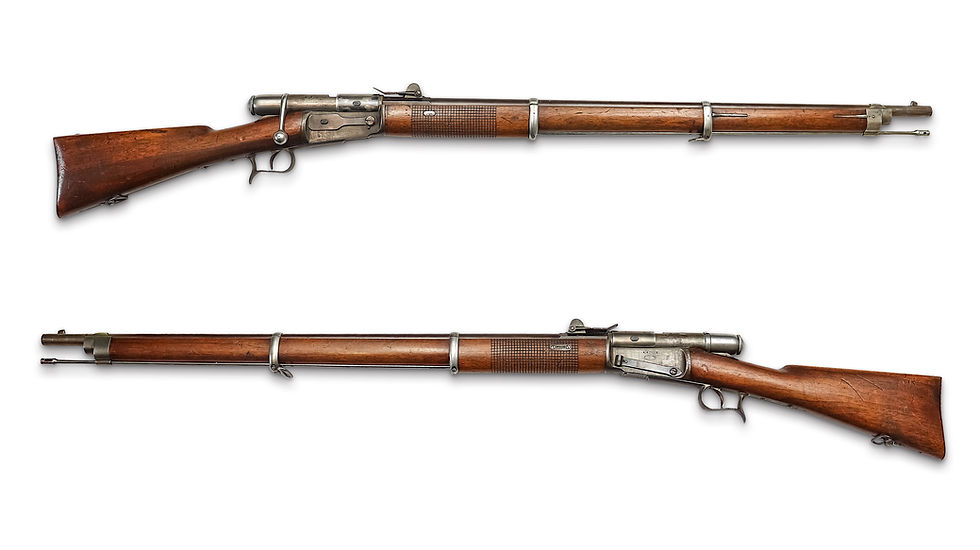Swiss Straight-pull action rifles
- Thomas Anderson

- Aug 20
- 4 min read
In 1884, French chemist Paul Vieille invented smokeless powder. The French army was quick to adopt (too quickly?) its Mle1886 rifle chambered for a cartridge using this powder, giving its soldiers a significant tactical advantage. All other nations around the world joined the race to develop smokeless powder and reduce caliber, sometimes to 8mm or 6mm ammunition. Switzerland naturally followed suit.

Numerous cartridge tests were carried out from 1887 onwards, notably with Eduard Rubin. To put it simply, the Gewehr Patrone 1890 was created: a semi-ogival bullet with a copper-nickel jacket and a lead core wrapped in greased paper. SIG offered its designs for the rifle, but without success, as it now faced stiff competition from Rudolf Schmidt, director of the Waffenfabrik in Bern. W+F Bern was initially just an assembly and quality control workshop for weapons. SIG and its subcontractors manufactured the various parts and components, and Bern assembled everything and affixed the appropriate inspection stamps. This was a real blow to SIG, and some criticized the choice of Schmidt's rifle as favoritism. In the end, it was his rifle that was chosen and adapted as the Model 1889..

An elegant rifle with an intriguing straight bolt action and prominent 12-round magazine. As was often the case at the time, the rear sight starts at 300m. However, the cavalry also needed to be equipped, and the problem with the Schmidt system was that the bolt was very long, making it impossible to produce a carbine version without sacrificing too much barrel length. SIG came up with a carbine based on the Mannlicher system: it also had a straight action, but the bolt was half the length.

Rudoft Schmidt believed that his rifle was perfect and that the length of the bolt could not be changed. This was not the opinion of inspector Vogelsang, who managed to propose a very simple modification, moving the locking lugs forward on the main body of the bolt. This made the bolt more rigid and also improved the rifle's accuracy, which was given a new name: the M1889/96. Contrary to what the name might suggest, the M1889/96 was not simply a conversion of Schmidt's M1889 modified in 1896. It was a new model, even though the two weapons were almost identical in appearance.

With this new bolt action, it was now possible to manufacture shorter weapons. This led to the rapid introduction of the 1897 Cadet rifle for training young marksmen. In addition, the M1893 cavalry carbine was not very popular: remounting the bolt was very difficult for cavalrymen and breakages were frequent. Two weapons were then developed: the 1900 short rifle for fortress troops and artillerymen (among others) and the 1905 cavalry carbine. Switzerland thus acquired a set of weapons that were 100% Swiss in design.



However, another change was soon to come: in 1898, France further improved its 8 mm Lebel cartridge by adopting a pointed bullet. This bullet shape was once again copied by other nations in order to keep up. Of course, the Swiss followed suit, and thus the 7.5x55 GP11 cartridge was born. It is important to understand that the pressure developed by the GP11 is much higher than that of the GP90, and that as a result, all the weapons that the Swiss had developed up to that point were no longer suitable for firing the new cartridge. Two decisions were made: to develop a new weapon and to convert the existing ones. This resulted in:
New Gewehr 1911
New Karabiner 1911
M1889/96 converted in Gewehr M1896/11
KG1900 converted in K00/11
KK1905 converted in K05/11


Weapons that have not been converted and are still in their original configuration are very rare today. It should be noted that the Kar.11 replaced the 1900 short rifles and the 1905 cavalry carbines because, during development, it became apparent that the carbines and short rifles tested were so similar that it was decided to produce a single weapon for all branches of the army.
This is also the reasoning behind the Karabiner M1931: the Kar.11 was highly appreciated by the troops for its lightness and compactness. The Gewehr M1911 is a good rifle, but it is very cumbersome for maneuvers—remember that a soldier spends 99% of his time carrying his weapon, not shooting it! It was therefore considered to discontinue production of the G11 in order to focus on the K11 and thus supply the entire army. However, the K11, despite its high quality, did not have the same level of accuracy as the G11. The solution was found with the Kar.31: the bolt was completely redesigned to be much shorter with the locking lugs at the front. The reduction in the length of the bolt and, consequently, the receiver, made it possible to lengthen the barrel while keeping the overall length of the weapon almost the same as the Kar.11. In addition, the Kar.31 was cheaper to manufacture and more accurate.

On the eve of World War II, the Swiss army adopted a rifle (or karabiner in German) that would equip all branches of the armed forces, from infantrymen to artillerymen to fortress troops. Rifle grenade launchers were developed for the Kar.31, and the 31/42 and 31/43 sniper rifles were derived from it. the Kar.31 never saw combat but it is one of the finest bolt action rifle ever made and is highly appreciated today by sport shooters.

All the history, variants, bayonets and accessories will be detailed in upcoming book:


Comments